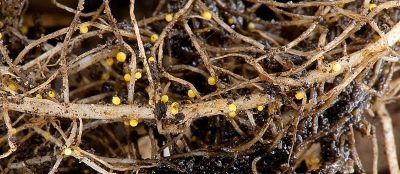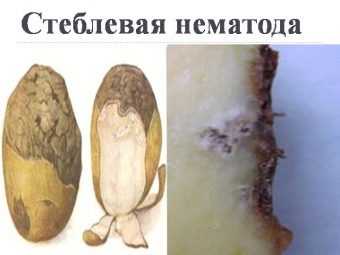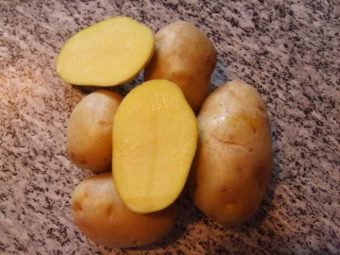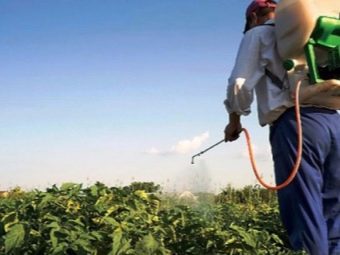Potato nematode: pest description and control methods
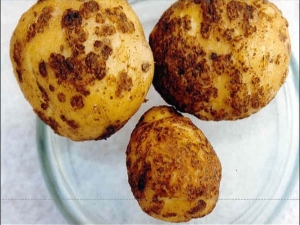
In our country, nematodes were found in the late forties of the last century.For seventy years, this parasite has spread throughout the country from south to north. In total, there are more than twenty thousand species of nematodes in nature, these parasites are steadily expanding their range, causing problems in agriculture in different countries. The most dangerous nematodes for potatoes.
What it is?
The cause of many ills for agriculture can be a voracious parasite - a nematode. It does not pose a danger to humans, but a potato nematode, for example, can completely destroy the crop.
The worm has microscopic dimensions, but the description of indirect signs of infection is quite simple:
- plants slow growth;
- leaves turn yellow and dry out;
Nematodes can enter the body of the plant in different ways, which are quite difficult to track. Microscopic worms can bring summer residents through untreated tools, they are also transferred to shoes, spores can be brought along with moisture and wind.
Varieties
Potato plants are attractive for such nematode species:
- golden;
- pale;
- silver;
- stem.
Golden
The golden nematode, which has been terrorizing Europe for more than a century, is especially dangerous.
And also this parasite is also called the soil nematode. It affects mainly plants:
- pepper;
- tomatoes;
- potatoes;
- turnips;
- beets.
- legumes;
- pumpkin;
- cucumbers.
The parasite has a body size of 0.2-1.4 mm, the worm at an early age has a white color, in the mature state, it casts a golden color. Roots suffer first of all, nematodes suck out all useful substances from them. A pregnant cyst-forming nematode female grows in size two to three times, becoming like a ball covered with a caramel color shell. One female can give birth to up to two hundred offspring at a time (sometimes this number can be up to half a thousand).
In early spring, parasites attack plants and eat their roots. In one season, up to two generations of these dangerous worms can change. To fight nematodes is not easy; their larvae are well protected and hardy, they are not afraid:
- frost;
- floods;
- high temperatures;
- radiation;
- toxins.
Golden nematodes are able to be in a state of suspended animation for ten years.
Stem
The nematode stem has a length of from 0.9 to 1.9 mm. Females lay up to 350 eggs. In one year, up to 5 generations can change. Stem potato nematode is one of the brightest representatives of phytohelminths. It feeds on root systems:
- tomatoes;
- beets;
- garlic;
- Luke;
- sunflower;
- legumes.
The potato suffers most from the stem nematode. The development of generation occurs from three weeks to two months, a lot depends on the ambient temperature. Wintering takes place in the form of eggs or larvae. Anabiosis is absent.
The stem nematode is very fond of the high moisture content in the air; if summer is rainy and there is little sunshine, the parasite reproduces exponentially. Huge areas of healthy crops can be destroyed in a short time.
Pale
The pale potato nematode is a part of the cyst-forming parasites of the heteroderite family. In addition to potatoes, it also affects:
- eggplants;
- tomatoes
It reproduces in a bisexual way. Loves the climate of the middle zone. Fecundity up to 450 individuals, sizes 375-532 microns.
The male does not feed for one week, he fertilizes the female and dies. The larvae spring out of the eggs, penetrate the roots. After a short time they are destroyed.
The area of the pale nematode (striking potato tubers) is the same as the golden relative. Such "kids" is able to completely eat the crop. Infection is possible from seedlings or soil. Parasite eggs are not afraid of low temperatures, the female lays them directly in the tuber itself. The incubation period lasts about three weeks.
Up to 90% of the crop may die when a similar misfortune.After the appearance of nematodes, it is not possible to plant any crops on such a soil. It will take years of reclamation and treatment of such a site, sometimes the time can be delayed up to ten years.
Another harm that the nematode brings to the plant. The action of worms is a kind of a ram, pathogenic microorganisms, a fungus that “eat up” the remnants of a culture, are attacked by a weakened plant through a punctured hole.
Infected land is treated with toxins (insecticides), but cysts are 100% very difficult to destroy. Modern means of pest control can suppress the population of parasites, to reduce the damage caused by them. As practical experience shows, it is impossible to completely get rid of nematode larvae.
Signs of appearance
Nematodes can be detected when there are obvious signs of its appearance on the leaves and stalks of plants. This happens most often after 6-7 weeks after landing. Signs of nematode infection:
- slowing plant growth;
- the yellowness of the leaves, which are located closer to the ground;
- twisting stems;
- faded bloom;
- general underdevelopment of bushes;
- roots are painted in dark brown Kohler.
When the growing season lasts, nematodes cannot be found, just on one “beautiful day” they suddenly appear everywhere. An indirect symptom can be a thickening of the stems, as well as the fact that the bushes become too “curly”. Another clear sign is the appearance of white spots on the tubers and the loosening of the structure of the tuber. And there may also appear brown spots that quickly grow in size.
Prevention
Measures that can be effective - is to comply with all conditions of crop rotation. There is a high probability that this parasite will appear in those areas where potatoes are grown from year to year for a long period. Potatoes are best planted after legumes (or cereals), letting the soil rest and resume planting four years later.
After harvesting, the plot should be well cultivated, removing half-rotten roots from the ground. Carefully wash and disinfect garden tools, often even formalin solution is used for these purposes. In no case can not plant tubers, if there is even the slightest suspicion of their "ill health". Treat antiseptics seedlings, just in case rinse the tubers in warm water. Strengthen the immunity of seedlings by treating them:
- ash;
- superphosphate.
Plants must have good nutrition, which also contributes to their resistance. Necessary trace elements such as:
- zinc;
- copper;
- potassium;
- boron.
It is recommended to grow potatoes that have good resistance to nematodes. Nine-tenths of all these measures on duty can be made safe to reduce the risk of infection with this terrible parasite. Special varieties of potatoes that are not afraid of nematodes:
- "Dolphin";
- "Picasso";
- "Garnet";
- "Color";
- "Belorussian";
- "Prior".
If the larva gets into such tubers, then where it has penetrated, the potato tissue dies, the parasite dies of starvation. But it should be remembered that the same varieties are forbidden to plant, there is a threat of the development of immunity in nematodes. Every four years should be changed varieties of potatoes.
Shrubs that have been attacked are immediately dug out and burned, this is the only way to protect against the parasite. The infected plant cannot be shaken, cysts can easily scatter throughout the district; in this case, a large area will be struck, especially if the weather is windy. Plants afflicted with a nematode are often placed in a hole and watered with a chlorine solution. The nematode should be fought non-stop, it is a very insidious pest, its elimination is possible only with the help of complex system measures. In late autumn, the areas where potatoes are supposed to be grown are processed with lime. In early spring, each well is put:
- manure (two handfuls);
- wood ash (one handful);
- bird droppings (one teaspoon).
This method allows you to protect against nematodes and feed the plants.
Avian droppings effectively destroy the larvae of the parasite. Make a solution in the consistency of 1:20 and pour the potatoes with this composition. On average, one square meter can leave up to one bucket of this solution.
But you can also use urea or mineral fertilizers, they also prevent the reproduction of this parasite. Nematodes "love" ringed worms. If in the early spring to treat the area with organic fertilizers, then thereby it is possible to attract the appearance of worms in large quantities. There are special preparations that contain annelids ("Nemabakt", "Protection"). Along the perimeter, you can plant plants that repel nematodes, highlighting irritating substances:
- marigold;
- nasturtium;
- calendula;
- legumes.
If the area of the site is infected, it is sown with winter rye. Usually this happens after the first week of September, then before the cold the plants will have time to develop. With the advent of the first snowflakes cut off, laid on the soil and finely crumble with a bayonet spade. The resulting mass is sprayed with the composition "Baikal EM" (the solution is made one to a hundred). After it warms up in spring and the snow melts, the mass is mixed with the ground, dug up.
Chemicals are recommended to be used only in case of a severe lesion, when there is no other chance to get rid of the pest. Substances are powerful toxins, therefore safety precautions should be observed, handled with them, observing safety standards.
Non-resistant varieties are very popular in our country. There are more than seventy positions in the register of the Russian Federation. If taken as a percentage, it is more than 30% of the total number of crops used.
The greatest result is observed in such varieties as "Impala" and "Rocco" (77% and 78%). Getting into the tuber of such a potato, the nematode larvae does not find enough food in it, the parasite does not develop, and it dies.
Potato Treatments
Not bad helps to get rid of nematodes chemical compound "Basudin", it is quite an effective tool that can solve the problem also with the wireworm that kills the roots of plants and potato tubers.
It should be borne in mind that by themselves toxins can only be of help, the fight against this dangerous parasite should be carried out by all methods according to the developed strategy. Just “pour on and forget” chemistry will not work, it will not solve the problem.
Nematodes should be monitored by supervisory authorities, in case of their occurrence it is necessary to inform the official organization - phytocontrol. Experts will be able to give practical advice on how to deal with this scourge.
It is important to carry out preventive measures that are an effective tool in the fight against this harmful parasite.
How to protect potatoes from nematodes, see the next video.






